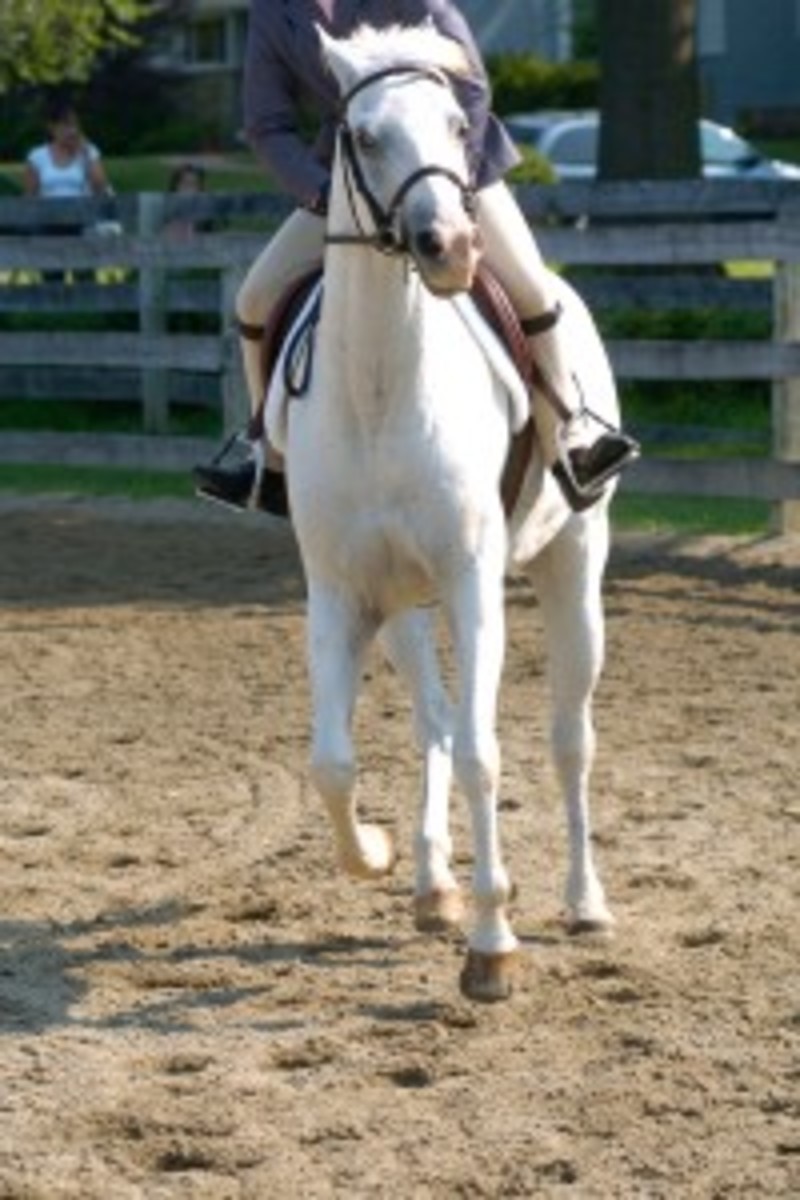Question:My Thoroughbred gelding was a star in flat classes until he started cutting in toward the center of the ring with every canter-walk transition. He does this no matter how much ?inside leg pressure I use. What should I do?

Amanda Steege
Answer: Sometimes young horses are so star-struck at their first competitions that they behave perfectly. Trying to make sense of their new surroundings, they pay very close attention to their riders. As they ?become more comfortable, though, they begin to look around and test their boundaries. That’s when some greenies develop little bad habits, such as the one you’ve described.
On the other hand, if your horse is older and more seasoned, he may be so familiar with the flat-class sequence of events that he’s simply anticipating the announcer’s command to line up in the center of the arena.
Whichever case you’re dealing with, the solution is to go back to basics. It sounds like your horse is throwing his shoulder in, making it difficult for you to steer no matter how much inside leg you use. To correct this, you need control over his shoulders as well as his hindquarters. Review with him the fundamental concepts of yielding away from your legs and bending in both directions by practicing lots of changes of direction, circles of different sizes, figure eights and serpentines at the trot.
For example, in a serpentine, after you turn left to cross the centerline, straighten your horse for a few strides, then ask him to bend to the right by using a slight indirect right rein, bringing it back toward your right hip, then an inch or two toward your left hip (but not so far that your hand crosses his neck). Use a steady direct left rein to control his speed, but don’t pull so hard that his head and neck turn to the left. Squeeze your right leg actively at the girth, while maintaining steady pressure with your left leg just behind the girth to prevent his haunches from swinging out. Meanwhile, concentrate on balancing your weight over the middle of your saddle, keeping your eyes looking up in the direction you’re going.
The goal is to bend him just enough so that you see his inside eye. This will prevent him from dropping his shoulder and cutting to the inside. Once this bend is established, ask him to move a few steps away from your right leg before making the right turn. After you complete the turn, straighten him again and reverse your aids to ask for a left bend and a few leg-yield steps in the other direction before turning left.
Once your horse is bending well in these exercises, practice keeping a slight inside bend while making transitions: walk to trot and trot to walk, then walk to canter and canter to walk. Then ask a few other riders to join you in a mock under-saddle class. If your horse still tries to cut in during the canter-walk transition, sit up tall in your saddle, firmly bring him back to the walk and ask him to leg-yield to the rail. With a few repetitions, he’ll get the idea.
Back in the show ring, try to plan ahead for each transition. When you hear the command for the walk, take a few strides to check that your horse has a correct, slight inside bend. (Under-saddle classes aren’t like playing Simon Says: You don’t have to make every transition the instant the announcer requests it.) Be sure that you’re sitting in the center of your horse and have equal pressure in your reins and legs before making the transition. And remember, keep your eyes up!
Amanda Steege trained with her father, top hunter/jumper trainer Mitch Steege, before starting her own business, Ashmeadow Farm, in Bedminster, New Jersey. Focusing primarily on hunters, she’s won championships or reserve championships at Devon, HITS Ocala and the Capital Challenge. Most recently, she rode Jessica Lundgren’s True Fate to the HITS Ocala 2008 Second-Year Green hunter circuit championship. She teaches both children and adults. Amanda also serves on the HITS East Coast Judges Advisory Committee and the AHJF board of directors.
This article originally appeared in the November 2008 issue of Practical Horseman.










